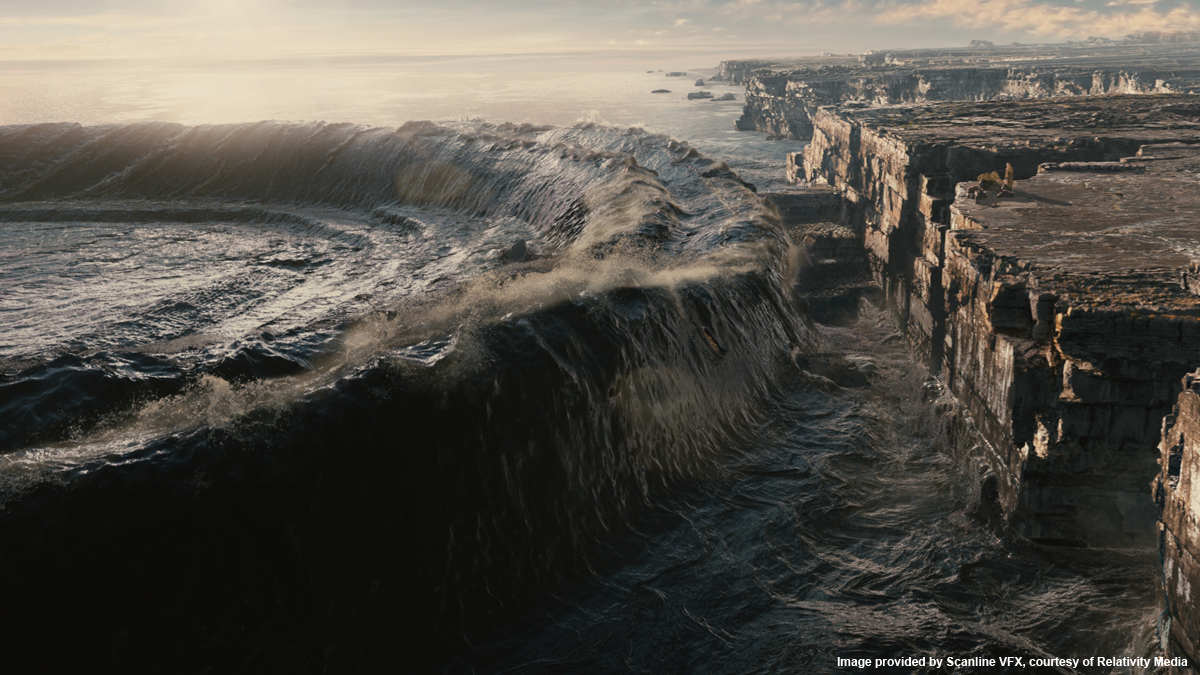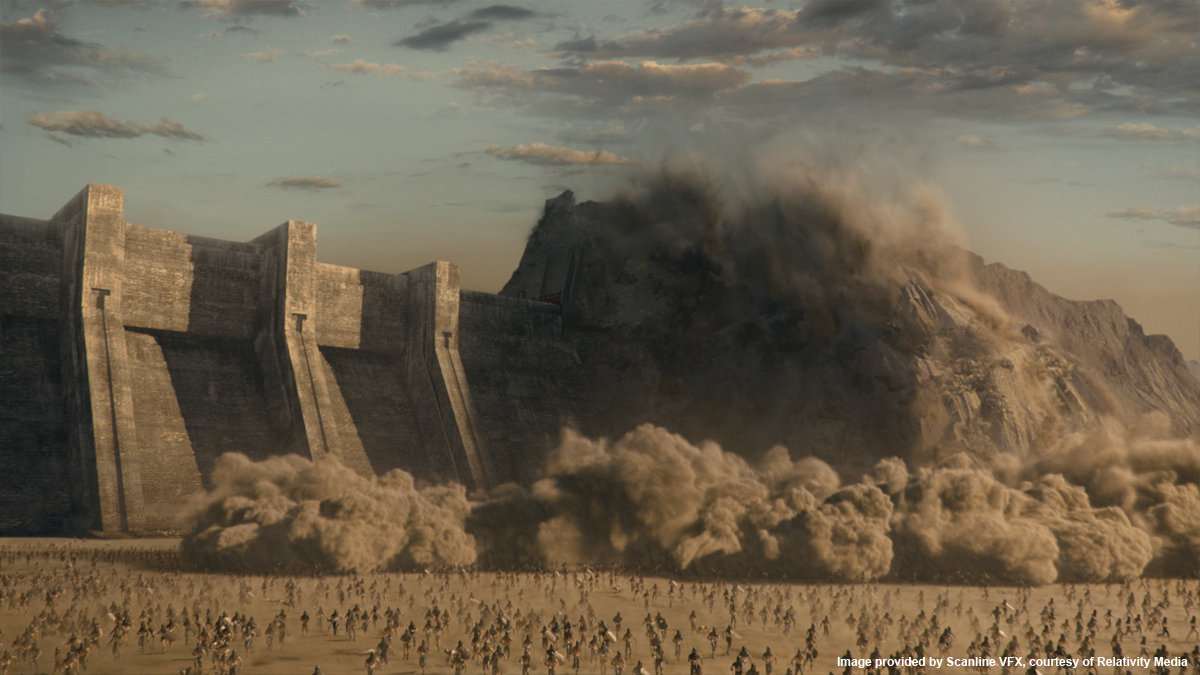Danielle Plantec is in the VFX for over 16 years. She has worked in studios as Digital Domain, Sony Imageworks, or ESC. In 2004, Danielle joined Scanline VFX and worked on films like THE DAY AFTER TOMORROW, 300 or HEREAFTER. She received a VES Award for this film.
What is your background?
I’ve been in Visual effects for 16 years. I was an effects artist at Digital Domain, Sony Imageworks, The Orphanage and at ESC for the MATRIX films. I joined Scanline Munich in 2004 as a CG Supervisor, and specialized in “Flowline” (Scanline’s Fluid effects system). I then opened Scanline’s Los Angeles Office in 2008 and our Vancouver Office this July. I am currently Vice President and VFX Supervisor at LA and Vancouver facilities.
How was the collaboration with director Tarsem Singh?
Tarsem has a wonderful eye and isn’t afraid to stray from the norm. He had some fantastic ideas which he planted and set us free to bring them to fruition. A perfect example was the Tsunami. Tarsem described it as a cross between an atomic bomb blast and a macrophotography slow motion droplet that generates a Tsunami in the Oil (contaminated ocean). He had a clear idea of what he wanted, but also gave us a lot of leway to design the simulations, the look and even what the shots would be, from composition to introducing additional shots to tell the story. I found him to be very supportive and easy going with a wonderful sense of humor.
What was his approach about VFX?
Tarsem chooses a team he respects, gives them the description of what he is after and then lets them use their creativity to execute that vision. He even said things like “do what you do best”.
What have you done on this show?
We did Mount Olympus, the Tsunami, The Interior Tomb environments and destruction and the Mountain collapsing and destroying the army.
Can you tell us more about the free fall of Poseidon and his impact on the water?
We created a digital version of Poseidon to intermix with the Close up practical shots. The environment was mostly matte painting with 3D volumetric clouds and full 3D rock terrain for everything close up, because there was a lot of parallax, that could not be painted.
For the Impact we were after something that was a cross between an atomic bomb and a macro photography droplet made out of a thick oil. We started with droplet idea and expanded on it by adding in shockwaves and thick mist of oil atomizing from the impact to add the atomic bomb feel and sense of scale.
How did you create the Tsunami?
We handled the wave in two different ways. For the wide shot we started with a continuation of the macro-photography idea that we used for the basis of our impact shot, and continued the simulation. This gave us our base, and of course we did it on a huge scale so it was also much slower. Then as we developed the look of what it would be in the close up shots we realized we wanted to have the swirling oily surface, so we simulated another fluid simulation on top of the base droplet style simulation. Then as development went on people started to want to see some of the additional elements we use in our water waves, like breaking spray and mists, so we added all of these on top of the base.
Did the black oiled aspect of the water caused you some troubles?
Tarsem had originally chosen black oil because he didn’t think CG could do realistic enough water. I remember meeting with him in Montreal and he laughed about it because we had recently seen our water work from 2012 and HEREAFTER and said he was trying to make it easier for the fx guys by making it oil. They had already coated the sets in the thick gloppy oil substance to show the aftermath of the tsunami. Water is one thing we definitely have down. So for us it is easier to make something match reality than to design and art direct something that doesn’t exist in nature. That being said, we had a lot of fun with it. We got to come up with something new.
How did you create the huge environment that is flooded by the wave?
We used a combination of 3D geometry and matte-painting, and in some cases full 3d geometry with a nice gloppy oil coating so we could get the oozing interactive feel on the rocks.
What were the references and indications you received for the Titans Temple?
The production had a wonderful art department, and they had supplied us with some beautiful concept art to define the look and mood of the temple. Most shots were also predefined by detailed previs that we kept as true to as possible.
Can you tell us in detail the impressive Temple destruction? How did you manage so many elements?
We handled many of the simulation elements separately and put them back together in comp. For example, when the large piece of basalt fell from the ceiling we handled that piece separately, and then did a secondary fine scale rock and dirt pass, followed by a detailed a dust fluid simulation.
Did you used some live action footages or is it full CG?
No the Temple destruction is full CG. Zeus is real, but he’s very tiny in frame.
Did you shared some assets with other vendors especially for the Temple and the Mountain?
The Mountain set was designed by a matte-painting company in Canada, for several sequences earlier in the film. We then took their paintings and built out underlying rock geometry so we could destroy the mountain. In order to get a realistic feel we needed to go from what in a still could be a matte painting to full shaded geometry.
Inside the temple we provided the environment work for the Amazing titan battle sequence from Tippett. We had a couple of shots where our destruction squashed some of their titans. In those cases Tippett provided us guide geometry of what would hit the titans, and then we replaced it with real destruction pieces. and dust elements. They also provided with everything we needed to be able to integrate their characters into our environment in comp. Because everything was so nicely separated out we were able to get lot of depth and destruction and dust elements wrapping around and between their characters.
Was there a shot or a sequence that prevented you from sleep?
Going into it I thought designing Mount Olympus would be our easiest sequence. I was very wrong about that. This was the one that had some designs, but really wasn’t defined. We went through dozens of completely different styles before we narrowed in on the final result.
How long have you worked on this film?
On and off for a year with a skeleton crew at times, and a complete hiatus for a couple of months while.
How many shots have you done?
About 150.
What was the size of your team?
Our artists all work on multiple shows, so it’s difficult to say. We had a fairly small team with a few stops and starts while the edit was being designed, We worked over the course of a year on and off with a team of about. Approximately 30-35 artists.
What is your next project?
We have several great shows in the moment that are delivering in February, but most of what we do is fairly secret until after the movie is released.
What are the four movies that gave you the passion for cinema?
Not so much Cinema, but Visual Effects.. there are so many along the way that re-spark the love of VFX
Early inspiration:
THE LAST STAR FIGHTER
BIG TROUBLE IN LITTLE CHINA
BLADE RUNNER
ID4 – INDEPENDENCE DAY
Rekindling the VFX spark:
THE MATRIX
FIGHT CLUB
A big thanks for your time.
// WANT TO KNOW MORE?
– Scanline VFX: Official website of Scanline VFX.
© Vincent Frei – The Art of VFX – 2012








